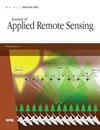ComS-YOLO: a combinational and sparse network for detecting vehicles in aerial thermal infrared images
IF 1.4
4区 地球科学
Q4 ENVIRONMENTAL SCIENCES
引用次数: 0
Abstract
Vehicle detection using aerial thermal infrared images has received significant attention because of its strong capability for day and night observations to supply information for vehicle tracking, traffic monitoring, and road network planning. Compared with aerial visible images, aerial thermal infrared images are not sensitive to lighting conditions. However, they have low contrast and blurred edges. Therefore, a combinational and sparse you-only-look-once (ComS-YOLO) neural network is put forward to accurately and quickly detect vehicles in aerial thermal infrared images. Therein, we adjust the structure of the deep neural network to balance the detection accuracy and running time. In addition, we propose an objective function that utilizes the diagonal distance of the corresponding minimum external rectangle, which prevents non-convergence when there is an inclusion relationship between the prediction and true boxes or in the case of width and height alignment. Furthermore, to avoid over-fitting in the training stage, we eliminate some redundant parameters via constraints and on-line pruning. Finally, experimental results on the NWPU VHR-10 and DARPA VIVID datasets show that the proposed ComS-YOLO network effectively and efficiently identifies the vehicles with a low missed rate and false detection rate. Compared with the Faster R-CNN and a series of YOLO neural networks, the proposed neural network presents satisfactory and competitive results in terms of the detection accuracy and running time. Furthermore, vehicle detection experiments under different environments are also carried out, which shows that our method can achieve an excellent and desired performance on detection accuracy and robustness of vehicle detection.ComS-YOLO:用于在航空热红外图像中探测车辆的组合稀疏网络
利用航空热红外图像进行车辆探测受到了广泛关注,因为它具有很强的昼夜观测能力,可为车辆跟踪、交通监控和路网规划提供信息。与航空可见光图像相比,航空热红外图像对光照条件不敏感。然而,它们的对比度低,边缘模糊。因此,我们提出了一种组合稀疏只看一次(ComS-YOLO)神经网络,以准确、快速地检测航空热红外图像中的车辆。其中,我们调整了深度神经网络的结构,以平衡检测精度和运行时间。此外,我们还提出了利用相应最小外部矩形对角线距离的目标函数,从而避免了在预测框与真实框之间存在包含关系或在宽度和高度对齐的情况下出现不收敛。此外,为了避免训练阶段的过度拟合,我们通过约束和在线剪枝消除了一些冗余参数。最后,在 NWPU VHR-10 和 DARPA VIVID 数据集上的实验结果表明,所提出的 ComS-YOLO 网络能有效识别车辆,漏检率和误检率都很低。与 Faster R-CNN 和一系列 YOLO 神经网络相比,所提出的神经网络在检测精度和运行时间方面都取得了令人满意和具有竞争力的结果。此外,我们还进行了不同环境下的车辆检测实验,结果表明我们的方法在检测精度和车辆检测鲁棒性方面都能达到理想的优异性能。
本文章由计算机程序翻译,如有差异,请以英文原文为准。
求助全文
约1分钟内获得全文
求助全文
来源期刊

Journal of Applied Remote Sensing
环境科学-成像科学与照相技术
CiteScore
3.40
自引率
11.80%
发文量
194
审稿时长
3 months
期刊介绍:
The Journal of Applied Remote Sensing is a peer-reviewed journal that optimizes the communication of concepts, information, and progress among the remote sensing community.
 求助内容:
求助内容: 应助结果提醒方式:
应助结果提醒方式:


